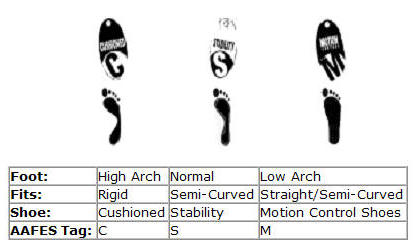Selecting the Proper Running Footwear
Determining Shoe Size. The first step to proper fitting is to measure both feet. Your footwear sales associate will measure both feet using the “Brannock Device.” Wear the socks you will run in when trying on running shoes. Walk and run in the shoe on a hard surface while trying them on. Buy shoes after being on your feet for a few hours. Make sure the shoes are comfortable when you buy them.
“Wet Test-What is my foot type?” Second, you can take the simple Wet Test to determine what kind of foot type you have and what shoe-shape you should look for. Basically, running shoes have one of three different shapes: straight; semi-curved; or curved. To take the test, wet your foot and then stand on any surface that will leave an imprint of your foot. (Example: Use a brown paper bag from the grocery store or dark construction paper). When you look at this imprint, you should find that you have one of the three most common foot types. While not every foot completely mimics these three types, you can still use the Wet Test to determine your general foot type and the shoe shape most likely to benefit your running.

NOTE: Circle the foot type that matches your foot assessment results.
The High-Arched Foot
Foot Characteristics: A curved, high-arched foot is generally termed an under-pronated foot. This type of foot doesn’t pronate enough so it’s not an effective shock absorber.
Best Fit: Curved shape
Best Shoes: Cushioned (“C” tag) shoes with plenty of flexibility to encourage foot motion and plenty of mid-foot cushioning. Stay away from motion-control or stability shoes that reduce foot-mobility.
The Normal Foot.
Foot Characteristics: A normal foot lands on the outside of the heel, then rolls inward (pronates) slightly to absorb shock. Runners with a normal foot and normal weight are usually considered biomechanically efficient and don’t require motion-control shoes.
Best Fit: Semi-curved shape
Best Shoes: Stability shoes with moderate control features such as a two-density mid-sole. (“S” tag)
The Low-Arched Foot.
Foot Characteristics: This imprint usually indicates an over-pronated foot that strikes on the outside of the heel and rolls inward (pronates) excessively. Over time, this can cause many different kinds of over-use injuries.
Best Fit: Straight or semi-curved shape
Best Shoes: Motion-control shoes (“M” tag) or stability shoes (“S” tag) with firm mid-soles and control features that reduce the degree of pronation. Stay away from highly cushioned curved shoes that lack stability and control.